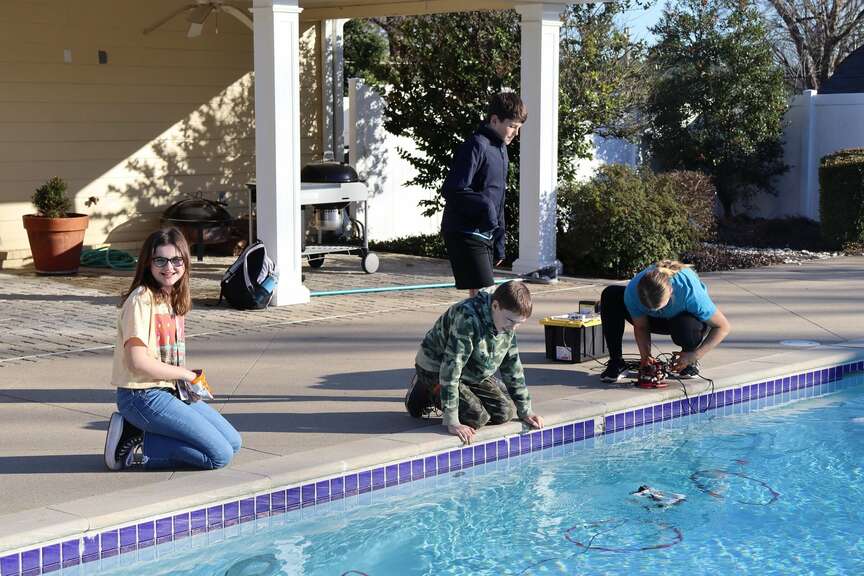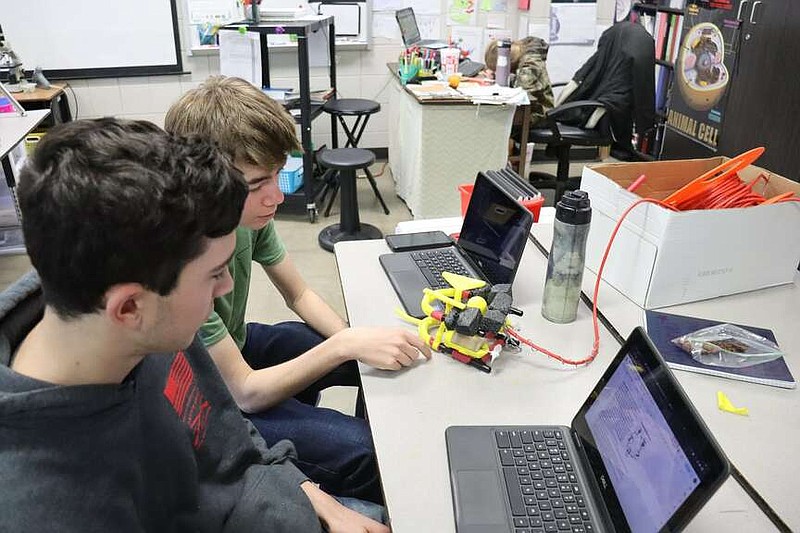PVC pipe, pool noodles, zip ties, 12-volt batteries: these are just a few of the supplies that Arkansas 4-H members are using to build remotely operated vehicles for the Arkansas SeaPerch Challenge, an underwater robotics competition.
The competition is scheduled to be held March 1 at the University of Arkansas at Little Rock, and the overall winning junior, senior and open teams will compete at the International SeaPerch Challenge at the University of Maryland in May.
The state contest is hosted by Arkansas 4-H, part of the Cooperative Extension Service, and the Electric Cooperatives of Arkansas.
Participants work within teams to construct remotely operated vehicles, or ROVs, and then steer them through underwater obstacle and challenge courses designed to mimic undersea exploration or space missions.
Brad McGinley, Grant County extension staff chair for the University of Arkansas System Division of Agriculture and director of the Arkansas SeaPerch Challenge, said the program prepares participants for real-world challenges.
"SeaPerch is based on the engineering design process, so it's about a continual process of improvement," McGinley said. "You develop a prototype of your ROV, we build it, we test it and we figure out what's wrong with it. Then we improve it, then we test it again. It's the same process that an engineer goes through -- that's what we're trying to do."
In Sheridan, members of the Grant County 4-H program, as well as students at Sheridan intermediate, middle and high schools, began preparing for the SeaPerch Challenge in October.
Since Arkansas 4-H began participating in the SeaPerch Challenge in 2016, a team from the Grant County 4-H program has won first place every year and advanced to the international competition.
McGinley said that the most significant impact the program has had on participants is in critical thinking skills and problem-solving.
"This is not a video game," McGinley said. "I think the first thing they realize whenever they build their ROV and put it in the water is that it's not as easy as it looks. You have to have a lot of trial and error, some 'stick-to-it-iveness,' to say, 'Hey, I'm going to stick this out.' Things are going to go wrong, and you've got to realize that it's OK. It happens right before you go into the competition, it happens during the competition, and you need to be able to say, 'How can I quickly solve this problem to the best of my ability?'"
Serena McGinley, a fifth-grade teacher at Sheridan Intermediate School and a 4-H and SeaPerch sponsor, said the program has equipped her students with many important skills.
"SeaPerch has impacted my students in so many ways over the years," she said. "They learn teamwork, how to use tools, how to problem solve, communication skills and so much more. These skills are not just 'SeaPerch skills,' but life skills.
"I have seen students find their passion for engineering in the program," McGinley said. "My students gain a confidence that can only come from accomplishing a task from the ground up. SeaPerch is so much more than a competition -- it is learning how to solve a problem in the most efficient way and communicating that information to others."
PRACTICE MAKES PERFECT
On a sunny afternoon in late January, Grant County 4-H members and Sheridan Middle School students gathered at the home of Beverly Wells, a former Sheridan School Board member, who lets the SeaPerch students use her outdoor pool to practice with their ROVs.
Brad McGinley said Wells' generosity has been critical to the success of the SeaPerch program in Grant County.
"It's a godsend that we have this," he said. "She's been so generous to allow us to come over here and basically take her pool over for several months. Before, we had an indoor pool that we were able to use, but they closed that pool down, and this is the only one we have access to locally. If we didn't have it, we would not be nearly as successful. She plays a big role in that."
Students clustered in their teams around the pool, adding new 3-D printed parts to their ROVs and testing their speed in the water.
"Today they're working on getting their ROVs to be neutrally buoyant, which means they don't float, and they don't sink," McGinley said. "That way they can just hover there under the water while they're working, so that takes some trial and error. Inevitably, there may be a propeller that falls off the first time -- things happen that we have to work out the kinks with."
Nearby, fifth-grade students and high school students worked in the classroom at Sheridan Intermediate School on their technical design reports. SeaPerch participants are also judged on these reports, where they document the construction and engineering design process for their robots.
Fifth-graders Abigail Martin and Jackson Knight said their first year participating in the program has been a learning experience.
"It's been fun and interesting," Martin said.
"It's way different than I thought it was going to be," Knight said. "I wasn't thinking PVC pipe, I was thinking a full-on robot, but it's still fun."
Martin said her favorite part has been going to the pool and testing their robot, where they learned they needed to add more buoyancy. Knight said he has enjoyed working on the obstacle courses -- during their last practice, they were able to use their ROV to open an "elevator" door on the underwater challenge course.
"Right now, I'm working on adding some graphs to our technical design report," Knight said. "These are our speeds so far. Our fastest has been 11 seconds to go from one side of the pool and back."
At another cluster of desks, fifth-graders Kayden Bosley, Ryder Maines, Isabella Klinedinst and Adalyn Thornton collaborated on their ROV, whom they've named Scuba Steve. Bosley said they have had to make a few adjustments to the robot's weight.
"We took off the lining so it would be lighter," Bosley said. "Me and Ryder had a little trouble once we got to the far end of the pool because we couldn't see through all the water, so we might need something bright at the front to help."
"We're trying to make it creative and unique," Klinedinst said.
Across the hall, high school students worked together on their technical design reports.
Gavin McGinley, son of Brad and Serena McGinley, and his teammate Callen Shaw have designed their robot from the ground up, including some 3-D printed parts.
"I'm thinking about making a foldable, 3-D printed hinge, but this is just our first thought," Gavin McGinley said, gesturing toward their robot. "I made all these motor houses from scratch, so they're all positioned in a really good spot."
"They're all of our own design," Shaw said. "Everything here was built from scratch. We know there are all sorts of sites you can go to with plans, but we designed these."
This is Shaw's second year participating in SeaPerch, and McGinley's fifth year.
"I like it because it's fun," McGinley said. "I get to hang out with my friends, and I like robotics."
"I like being able to work as a team and prove our accomplishments that we made, overcoming challenges," Shaw said. "We're working on our report right now. I enjoy seeing how our ROV changes from where we started to where we end up, that's one of my favorite parts about it."
"It's a little funky right now when it drives, but hopefully we'll work all the kinks out," McGinley said.
For more information about the Arkansas 4-H SeaPerch Challenge, visit 4h.uada.edu. To learn more about the SeaPerch program, visit seaperch.org/about. To learn about extension programs in Arkansas, contact a local Cooperative Extension Service agent or visit www.uaex.uada.edu.
Rebekah Hall is with the University of Arkansas System Division of Agriculture.
 Grant County 4-H members and Sheridan Middle School students gather at a community member's pool to practice steering their remotely operated vehicles, or ROVs, through the SeaPerch Challenge obstacle and challenge courses. (Special to The Commercial/University of Arkansas System Division of Agriculture)
Grant County 4-H members and Sheridan Middle School students gather at a community member's pool to practice steering their remotely operated vehicles, or ROVs, through the SeaPerch Challenge obstacle and challenge courses. (Special to The Commercial/University of Arkansas System Division of Agriculture)